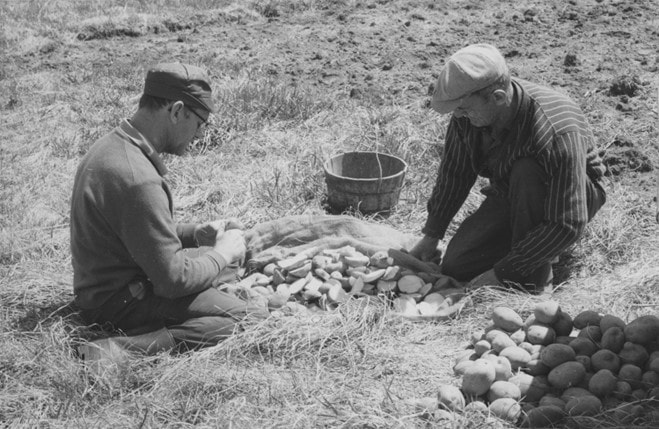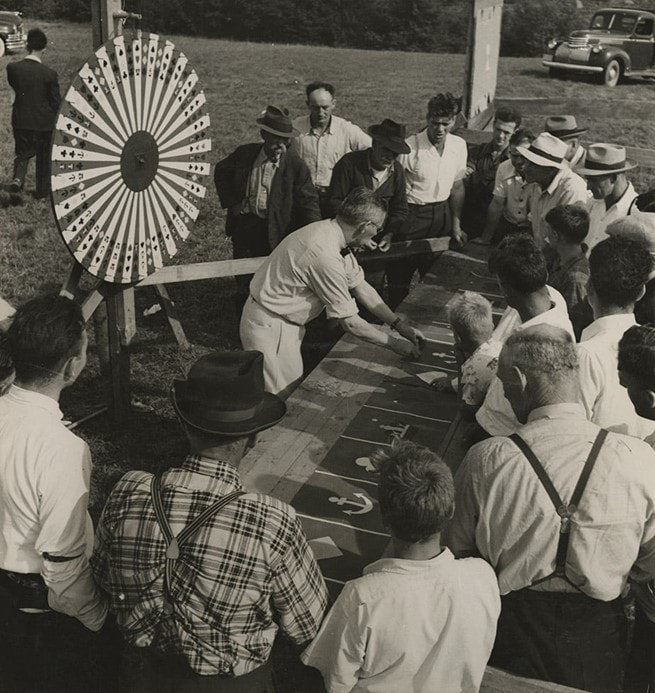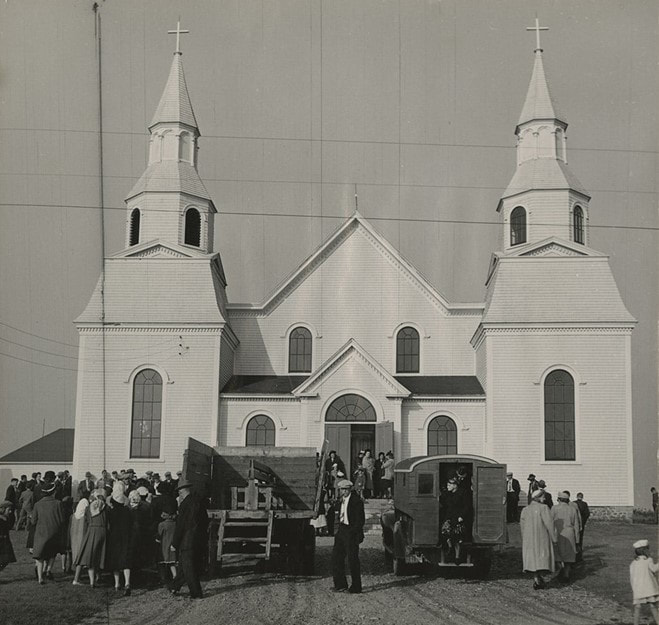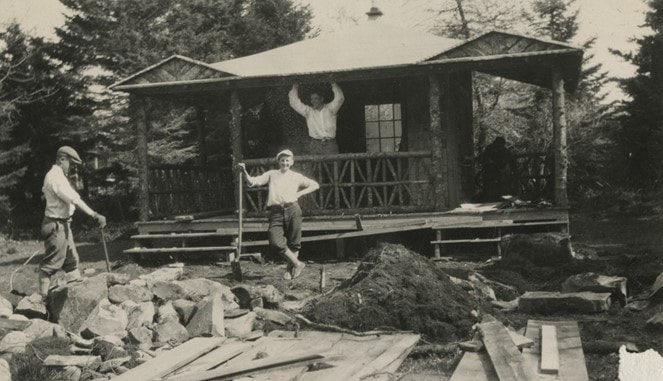News and Reflections: Ancient Place Names Close to Home "Baie Sainte-Marie" (Clare)-- March 18, 20233/18/2023
Baie Sainte-Marie Saint Mary's Bay, located in Digby County, Nova Scotia, was named "La Baie Sainte-Marie" by De Monts in 1604. The Acadians, who settled Clare in 1768 following the end of the Le Grand Dérangement, or "Great Upheaval," referred to the area as "Baie Sainte-Marie" and the name is still used today. First Nations peoples once called this bay "Wagweiik," meaning "the end." Acadian Antoine Solomon Malliet, who signed an Oath of Allegiance to the former King in 1768, was among the first to settle Clare. Malliet had returned to Nova Scotia after having been expelled by the British between 1755 and 1764 and used his Oath of Allegiance much like a passport during his travels there. The Municipality of Clare purchased the oath document in 2018, where it has been framed and preserved in its original state, for safe keeping. A newspaper article about Acadians in Clare, that was published by a Michigan newspaper in 1936 and is now in the public domain, includes the following first-hand observations about the Acadian community dating back to the mid 1800s: Although the Acadians were driven from the famous Land of Evangeline in 1745 their traditions and culture still live on in many a little French village in Nova Scotia that even now is not unlike the Grand Pre of the days when France ruled the new land. Images from Baie Sainte-Marie's Historic Past The “big church” located on the east side of the main road. In 1803, a new church was built on this site to replace the poorly built and drafty church on the point. It was destroyed in the fire of 1820 and was replaced by this one. The parish rectory, which was also rebuilt after the fire of 1820, is located across the road from the church. This rectory was destroyed by fire in 1893. Date: [ca. 1830] Reference: Musée Sainte-Marie The “big church”, as it was known, was completed in 1829 and served the parish until 1905. It was built on the same site as the church which had been destroyed in the fire of 1820 but was a bit bigger than the one which was destroyed. This church was demolished after the completion of the present church. Date: [ca. 1830] Reference: Musée Sainte-Marie 1 The site of the “big church” is now the location of the parish cemetery. Notice the monument across the road from the church. This is a monument to Father Jean-Mandé Sigogne whose remains were buried in front of what was at that time known as College Sainte-Anne. This college, which is now known as University Sainte-Anne, was, at the time, run by the Eudiste Priests and the college Rector was also the Pastor of the parish. Date: [ca. 1830] Reference: Musée Sainte-Marie The juvénat, the priest's residence, was built in 1894 to serve as rectory for the parish as well as residence for priests teaching at College Sainte-Anne. Note the barns to the right across the road from the juvénat. These barns were used to shelter the horses while their owners attended mass. Some of these barns have since been converted to homes. Date: [ca. 1900] Reference: Musée Sainte-Marie It is said that Father Dagnaud was somewhat envious of the other churches which had been constructed along Saint-Mary’s Bay. The Sacred Heart Parish in Saulnierville had built this church in 1880 and had added on to it a few years later. Father Dagnaud decided that Church Point had to have a church that would never need adding-on and would be the queen of all churches in the region. Date: [ca. 1900] Reference: Musée Sainte-Marie Progress of the construction in the summer of 1904, only one year after the blessing of the corner stone. Only four people were actually paid full time for their labour on the construction but approximately 1500 parishioners volunteered their time to help. Date: 1904 Reference: Musée Sainte-Marie In August of 1904 the church is decorated for the blessing of the bells. Note that the main building is almost completely shingled with only the steeple structure left to complete. Father Dagnaud wrote to his nephew in late 1903 and stated in his letter that “She will be superb…..The whole Bay will hear the echo of her bells…” Date: 1904 Reference: Musée Sainte-Marie Late 1904, the steeple is completed from the four turrets to the top. On this photo we can see that there was no elaborate scaffolding erected for the construction. Scaffolding was attached to the side of the building at the level where it was needed only. Date: 1904 Reference: Musée Sainte-Marie Late 1904 looking north with the “big church” on the right and College Sainte-Anne on the left. The building in the right center is the juvénat, the priests’ residence. The “big church” was demolished in 1906. Date: 1904 Reference: Musée Sainte-Marie This photo shows the church after full completion. Total cost of the construction was $29,958 but it is impossible to estimate the value of time and materials donated by the parishioners. The dormers on the roofs of the transepts were later removed, it is assumed that this was done when the roof was re-shingled in 1946. Date: [ca. 1910] Reference: Musée Sainte-Marie When Father Sigogne arrived in the parish in 1799 he started a tradition of processions to celebrate the Feast of our Lord, normally celebrated 60 days after Easter. This procession would follow paths and roadways near the church and on the campus of College Sainte-Anne. Date: 1947 Reference: Musée Sainte-Marie Construction of the schooner Nettie C. in Saulnierville, NS Reference: Harold Robichaud Collection Centre Acadien Series A, photo 11 Date: [ca. 1919] Fishermen's cabins and Cape Islanders in Cape Saint Mary's, NS Date: 1950 140 x 32.3 · 13.3 254 tons BUILT AT BELLIVEAU COVE Date: 1919 The Raymond sawmill in Meteghan Station, NS Date: 1905 Loading pulpwood on board a ship in Clare Date: 1950 Railway construction in Saulnierville-Station, NS Date: 1880 Minnie (LeBlanc) Geddry hangs a mailbag for pick-up by a passing train, in Maxwelton, NS Université Sainte-Anne Collection Centre Acadien Series Date: 1948 Villagers in front of a general store in Meteghan, NS Université Sainte-Anne Collection Centre Acadien Series Date: 1915 Riverport Motor Works, Meteghan-River, NS Université Sainte-Anne Collection Centre Acadien Series Date: 1918 Employees in front of the Meteghan creamery, Meteghan, NS Université Sainte-Anne Collection Centre Acadien Series Date: 1915 Wooden box factory owned by EM Comeau and Sons Université Sainte-Anne Collection Centre Acadien Series Date: 1912 Blacksmith shop specializing in the fabrication of horse buggy wheels Université Sainte-Anne Collection Centre Acadien Series Date: 1900 School teacher Delphine Saulnier with the students of the small school in Cape Saint Marys Université Sainte-Anne Collection Centre Acadien Series Date: 1950 Students and school bus in front of Jean-Marie Gay School, Saulnierville, NS Université Sainte-Anne Collection Centre Acadien Series Date: 1949 Bernard Saulnier and Herbie Saulnier prepare to plant their potatoes, Meteghan River, NS Université Sainte-Anne Collection Centre Acadien Series Date: 1974 Preparing firewood in l’Anse-à-l’ours, NS Université Sainte-Anne Collection Centre Acadien Series Date: 1920 Clearing the main road in Church Point, NS Université Sainte-Anne Collection Centre Acadien Series Date: 1942 Clam diggers in Cape Saint Marys, NS Université Sainte-Anne Collection Centre Acadien Series Date: 1950 Blessing of the Fleet in Meteghan, NS, by Monsignor Émile Bourneuf Université Sainte-Anne Collection Centre Acadien Series Date: 1950 Fête-Dieu procession in Meteghan, NS Université Sainte-Anne Collection Centre Acadien Series Date: 1916 Game of chance at Doucetteville parish picnic Université Sainte-Anne Collection Centre Acadien Series Date: 1950 Villagers arriving for Sunday mass in Saint-Alphonse, NS Université Sainte-Anne Collection Centre Acadien Series Date: 1950 Social life in Clare: eating, drinking, singing, dancing Université Sainte-Anne Collection Centre Acadien Series Date: 1900 The brass band, Collège Sainte-Anne, Church Point, NS Université Sainte-Anne Collection Centre Acadien Series Date: 1928 Father Louis Levesque with a hockey team from Université Sainte-Anne, Church Point, NS Université Sainte-Anne Collection Centre Acadien Series Date: 1952 Construction of a kiosk in the Petit Bois, Church Point, NS Université Sainte-Anne Collection Centre Acadien Series Date: 1900 Based upon the presence of a lighthouse n the background, AAMS Directors Jocelyne Comeau and Paul Tufts tell us that this was the small chapel at Church Point behind the University, which is no longer there. They note that the chapel at Pointe-à-Major looks like the one above as well. Jocelyne tells us that the Municipality of Clare has been allocated funding to enhance that site and the walk from there to Belliveau Cove, via a boardwalk along the shore. (See: https://www.historicplaces.ca/en/rep-reg/place-lieu.aspx?id=16023) Date: 1774 Link to:
Comments are closed.
|
Archives
June 2025
Category
All
|







































 RSS Feed
RSS Feed


